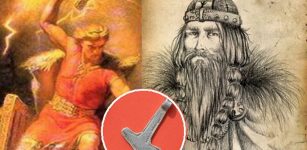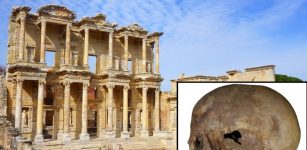Abundantia: Roman Goddess Who Was Shaking Her Gifts From Cornucopia – ‘Horn Of Plenty’
A. Sutherland - AncientPages.com - Abundantia (or Abundita) was a powerful, nourishing Roman goddess and a divine personification of abundance, prosperity, and good fortune. She was believed to be the one who formally assured abundant harvest.
 A silver statue of Abundantia. Musée Gallo-Romain, Lyon. source
A silver statue of Abundantia. Musée Gallo-Romain, Lyon. source
In Roman mythology, the goddess brought money and grain to people as they slept, shaking her gifts from the Horn of Plenty she was constantly carrying.
Personifications in Roman mythology played an important role and were a typical characteristic feature of the Roman religion. The ancient Romans personalized and worshiped human feelings, desires, moral concepts, and qualities such as hope, truth, fidelity, and more.
Roman personifications often appeared on the sides of Roman coins (especially those dated to the time of the Roman Empire). Characters from the Roman pantheon of deities were often used as idols.
The name 'Abundantia' literally means "overflowing wealth," her symbol is the cornucopia, symbolizing boundless abundance, often depicted in paintings and on friezes. The goddess was frequently described as a beautiful woman who spills the grain out of the cornucopia, the horn of plenty. It is a hollow horn-shaped container with things like fruit, coins, flowers, nuts, or other desirable things.
According to the Greek legend, Zeus accidentally broke a horn from the divine she-goat Amalthea, his foster mother, frequently mentioned in myths. He gave it to Amalthea, promising that it would supply whatever she desired in abundance, and so it happened. The horn would overflow with all good food, drink, and other riches.
In another version, the sacred goat filled the horn with flowers and fruits and gave it to Zeus, who placed the horn of plenty together with the goat, Amalthea, amongst the stars.
Abundantia has always been considered a beautiful goddess who brings success, prosperity, and good fortune to everyone she meets. She is the protector of investments, savings, and wealth.
 Left: Abundantia frequently appeared on Roman imperial coinage. source ; Right: Abundantia by Antonio Tarsia San Zanipolo Venice. source
Left: Abundantia frequently appeared on Roman imperial coinage. source ; Right: Abundantia by Antonio Tarsia San Zanipolo Venice. source
She can bring people to a place of acceptance, joy, and grace. In our modern society, the goddess remains the patron of gamblers – the revered 'Lady Fortune.'
Cornucopia Was Granted To Abundantia
A myth by Ovid (43 BC- 18 AD), a Roman poet who lived during the reign of Augustus, describes the Achelous, the god of all water and the world's rivers.
During one of Heracles' (Roman Hercules) missions to fight with Achelous, Heracles broke off one of his horns. The Naiads (freshwater nymphs) took up the horn and changed into the cornucopia granted to Abundantia.
It was with this 'horn of plenty' that she distributed food and money.
Abundantia Depicted On Roman Coins
Within Roman mythology, she was considered a minor deity, and there are only a few temples or signs of worship for the goddess Abundantia to be recognized in Rome.
Her personification, however, was frequently seen on the reverse of Roman imperial coinage, and she has been widely featured in art.
Beliefs In the Great Power Of Abundantia
The beautiful goddess can help us become recipients of divine gifts. She also gives us faith and the opportunity to follow our dreams and aspirations.
In Roman mythology, Abundantia gives money and grain from her cornucopia to people during sleep. In ancient Rome, it was believed that she entered the homes of people during the night,
She is a merciful and generous goddess who loves looking at human joy and listening to words of gratitude. She encourages us to turn to her in financial problems because she will gladly show us the way to the source of everything.
She wants us to be free from financial worries and have a comfortable life. She asks us not to fall into a paralyzing fear in the face of losses or lack of money because it blocks the flow of energy we need in our lives.
Updated on January 5, 2024
Written by – A. Sutherland - AncientPages.com Senior Staff Writer
Copyright © AncientPages.com All rights reserved. This material may not be published, broadcast, rewritten or redistributed in whole or part without the express written permission of AncientPages.com
More From Ancient Pages
-
 2,000-Years-Old Warrior Graves With Iron Swords, Mysterious Square Structures, Unearthed In Bejsce, Poland
Archaeology | Nov 21, 2019
2,000-Years-Old Warrior Graves With Iron Swords, Mysterious Square Structures, Unearthed In Bejsce, Poland
Archaeology | Nov 21, 2019 -
 Mystery Of The Brave Viking Chief Buried On The Gokstad Ship
Featured Stories | Mar 14, 2016
Mystery Of The Brave Viking Chief Buried On The Gokstad Ship
Featured Stories | Mar 14, 2016 -
 Did Our Ancestors Know About Artificial Intelligence?
Ancient Technology | Sep 2, 2015
Did Our Ancestors Know About Artificial Intelligence?
Ancient Technology | Sep 2, 2015 -
 Last Of The Giant Camels And Archaic Humans Lived Together In Mongolia Until 27,000 Years Ago
Fossils | Mar 24, 2022
Last Of The Giant Camels And Archaic Humans Lived Together In Mongolia Until 27,000 Years Ago
Fossils | Mar 24, 2022 -
 Memory Of Palmyra’s Ancient Ruins Preserved Thanks To One Man’s Dedication And Mini Models Of Lost Temples
Archaeology | Mar 24, 2021
Memory Of Palmyra’s Ancient Ruins Preserved Thanks To One Man’s Dedication And Mini Models Of Lost Temples
Archaeology | Mar 24, 2021 -
 Why Did Vikings Carry Decorative Swords That Were Useless In Combat?
Ancient History Facts | Jun 8, 2024
Why Did Vikings Carry Decorative Swords That Were Useless In Combat?
Ancient History Facts | Jun 8, 2024 -
 How Emma Of Normandy Risked Her Life To Save England
Featured Stories | Jun 30, 2025
How Emma Of Normandy Risked Her Life To Save England
Featured Stories | Jun 30, 2025 -
 Hel – Loki’s Terrible Daughter And Goddess Of The Land Of Dead
Featured Stories | Mar 26, 2018
Hel – Loki’s Terrible Daughter And Goddess Of The Land Of Dead
Featured Stories | Mar 26, 2018 -
 Ancient DNA Reveals Surprises About Life Of Early Africans
Archaeology | Feb 24, 2022
Ancient DNA Reveals Surprises About Life Of Early Africans
Archaeology | Feb 24, 2022 -
 Raven: Uncommonly Intelligent Bird, Symbol Of Providence, Wisdom And Prophecy
Featured Stories | Aug 4, 2025
Raven: Uncommonly Intelligent Bird, Symbol Of Providence, Wisdom And Prophecy
Featured Stories | Aug 4, 2025 -
 Bronze Age And Iron Age City Complex Once Known As Kummanni Unearthed In Turkey
Archaeology | Dec 4, 2018
Bronze Age And Iron Age City Complex Once Known As Kummanni Unearthed In Turkey
Archaeology | Dec 4, 2018 -
 Why Did Christian Viking King Harald Bluetooth Carry A Hammer Of Thor Amulet?
Artifacts | Apr 20, 2018
Why Did Christian Viking King Harald Bluetooth Carry A Hammer Of Thor Amulet?
Artifacts | Apr 20, 2018 -
 Fossilized Remains Of Homo Erectus Found On Submerged Sundaland, Java Reveal More Secrets
Archaeology | May 21, 2025
Fossilized Remains Of Homo Erectus Found On Submerged Sundaland, Java Reveal More Secrets
Archaeology | May 21, 2025 -
 Unique Study Of Skeletal Remains Reveals Grave Health Of Australian Pioneer Settlers
Archaeology | Apr 7, 2022
Unique Study Of Skeletal Remains Reveals Grave Health Of Australian Pioneer Settlers
Archaeology | Apr 7, 2022 -
 Unexplained Encounters With A Mysterious Being In South Dakota Reported – Why Is This Happening?
Featured Stories | Jul 9, 2024
Unexplained Encounters With A Mysterious Being In South Dakota Reported – Why Is This Happening?
Featured Stories | Jul 9, 2024 -
 Mystery Of The Ancient Skull Found In Ephesus Solved – It Did Not Belong To Arsinoë IV, Cleopatra’s Sister
Archaeology | Jan 10, 2025
Mystery Of The Ancient Skull Found In Ephesus Solved – It Did Not Belong To Arsinoë IV, Cleopatra’s Sister
Archaeology | Jan 10, 2025 -
 Surprise! ‘Viking Ship’ Found On The Seabed Is Not What We Previously Thought And Rewrites Scandinavian Maritime History, Scientists Say
Archaeology | Mar 10, 2025
Surprise! ‘Viking Ship’ Found On The Seabed Is Not What We Previously Thought And Rewrites Scandinavian Maritime History, Scientists Say
Archaeology | Mar 10, 2025 -
 Bronze Age DNA Shows Direct Genetic Link To Current Inhabitants Of Southern Poland
Archaeology | May 4, 2020
Bronze Age DNA Shows Direct Genetic Link To Current Inhabitants Of Southern Poland
Archaeology | May 4, 2020 -
 Researchers Find An Elusive European Ancestor Of Lager Yeast In Ireland
Archaeology | Dec 14, 2022
Researchers Find An Elusive European Ancestor Of Lager Yeast In Ireland
Archaeology | Dec 14, 2022 -
 Water Storage Failure And Short-Lived Koh Ker Capital Of Khmer Empire
Archaeology | Nov 1, 2019
Water Storage Failure And Short-Lived Koh Ker Capital Of Khmer Empire
Archaeology | Nov 1, 2019
